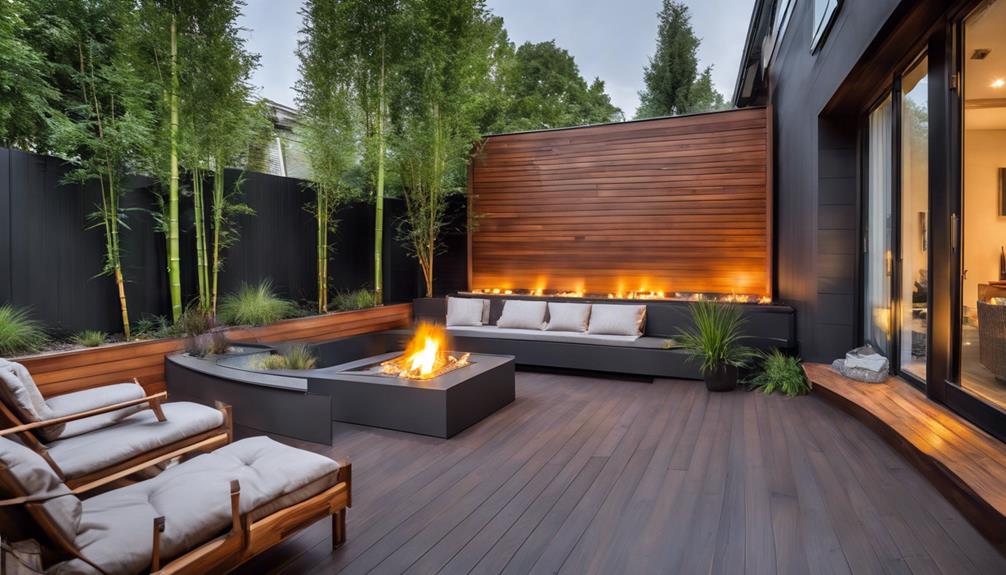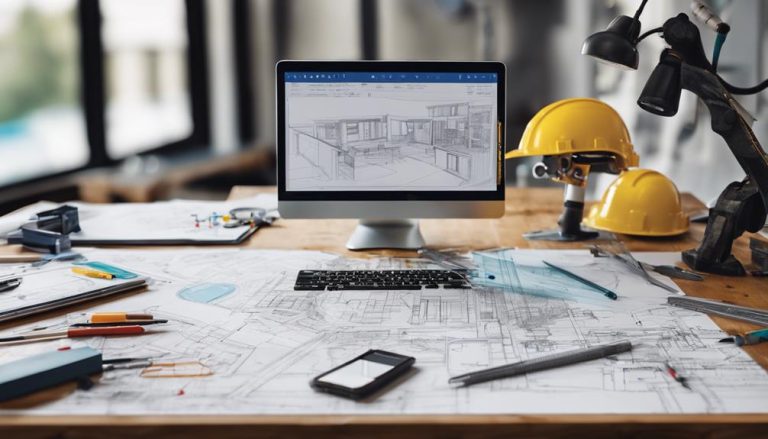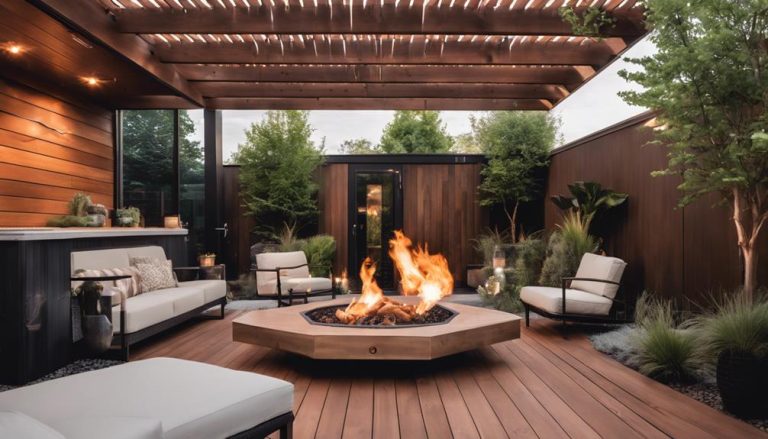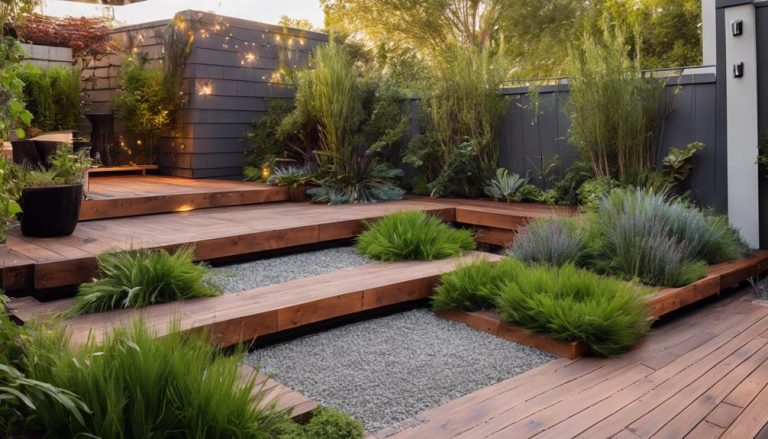7 Popular Deck Design Trends You Should Know
Modern deck design trends are transforming outdoor spaces by embracing sleek materials, integrated lighting, and minimalist railings. The use of composite decking, aluminum railings, and tempered glass panels enhances durability and aesthetic appeal through a modern, streamlined look. Integrated lighting solutions, including LED strips and smart technology, offer convenience and energy efficiency, while minimalist railing designs with elements like cable systems and glass maintain seamless outdoor integration. These trends not only foster an enhanced outdoor experience but also increase property value through their eco-friendly and functional designs. Discover how these elements contribute to a modern, versatile deck appeal.
Deck Builder Highlights
- Incorporate composite decking for durability and low maintenance.
- Utilize sleek, minimalist railings with aluminum and glass for a modern aesthetic.
- Integrate LED lighting solutions for ambiance and energy efficiency.
- Include outdoor kitchens to enhance functionality and entertainment possibilities.
- Employ eco-friendly materials to boost property value and visual appeal.
Defining Modern Deck Elements
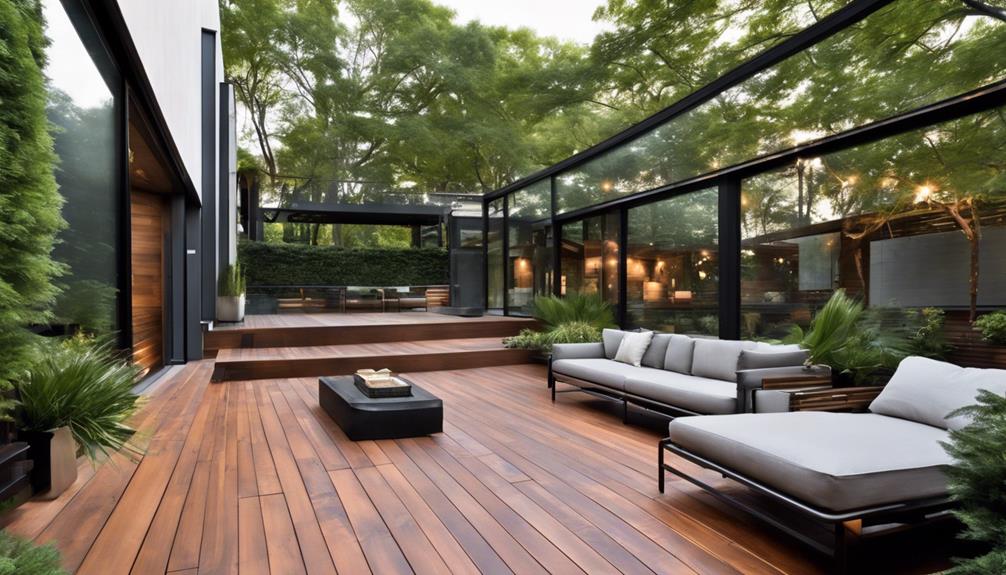
Modern deck design is characterized by the utilization of sleek material choices, integrated lighting solutions, and minimalist railings, which collectively contribute to both aesthetic appeal and functionality. With a robust foundation in deck construction, professionals are able to craft environments that expertly balance design and durability.
The adoption of high-performance composites and sustainably sourced woods exemplify the demand for materials that offer durability and environmental mindfulness, while strategically placed lighting enhances safety and ambiance. Additionally, minimalist railings are pivotal in maintaining unobstructed views and creating a sense of openness, consequently redefining outdoor living spaces with simplicity and elegance.
Sleek Material Choices
A growing number of homeowners and designers are embracing sleek material choices as the hallmark of contemporary deck design. The trend emphasizes clean lines and minimalistic aesthetics, often utilizing materials like composite decking, aluminum, and tempered glass.
Composite decking, made from a combination of wood fibers and recycled plastics, offers superior durability and resistance to weathering, all while maintaining an impressively uniform appearance. Its low-maintenance nature makes it an appealing option for those seeking longevity without the burden of constant upkeep.
In tandem with composite, aluminum has emerged as a favored choice for railing systems due to its lightweight nature, corrosion resistance, and modern look. The minimalistic frames provided by aluminum railings offer unobstructed views, enhancing the visual appeal of outdoor spaces.
Additionally, tempered glass panels are frequently employed for creating transparent barriers that blend seamlessly with natural surroundings, imparting an open and airy feel.
These materials not only align with the principles of modern design but also reflect a commitment to sustainable and eco-friendly practices. By incorporating these elements, contemporary decks become an extension of modern living spaces, synchronizing innovative design with functional practicality. The result is outdoor areas that are both aesthetically pleasing and architecturally relevant.
Integrated Lighting Solutions
Complementing the sleek material choices that define today's deck aesthetics, integrated lighting solutions have become pivotal in shaping modern deck elements. By intricately weaving lighting within the structural framework rather than treating it as an ancillary addition, these solutions enhance both functionality and ambiance. The seamless incorporation of lighting technologies such as LED strips, recessed fixtures, and solar-powered accents allows for the strategic illumination of stairs, pathways, and railings, thereby ensuring safety while crafting an alluring visual experience that extends the usability of outdoor spaces into the evening hours.
Integrated lighting solutions also offer versatility in design, enabling homeowners to customize the luminosity and color temperature to reflect their personal style preferences and complement natural surroundings. Advances in smart technology further enhance these features, providing users the convenience of controlling their deck's lighting settings via smartphone apps or voice activation, thus adding a layer of modern connectivity to traditional outdoor gatherings. The careful calibration of light levels, intensities, and distributions not only seeks to preserve the understated elegance of contemporary decks but also promotes energy efficiency, reducing environmental impact. These lighting innovations distinctly contribute to an outdoor ambiance that is as efficient as it is aesthetically pleasing.
Minimalist Railings Design
How does minimalist railing design define contemporary deck elements? In recent years, minimalist railings have emerged as a symbol of modernity in deck architecture. This design approach streamlines aesthetic elegance with functional superiority, capturing the essence of simplicity without sacrificing safety or structural integrity. Minimalist railings emphasize clean lines and subtle features, creating an unobtrusive yet sophisticated component to exterior spaces.
Components integral to minimalist railings often include:
- Slim Metal Frames: Utilizing materials like stainless steel or powder-coated aluminum, these frames provide strength with minimal visual obstruction.
- Glass Panels: Clear or frosted glass offers seamless visibility, integrating outdoor environments without literal barriers.
- Cable Rail Systems: Thin, tensioned cables create a sleek and minimal profile while ensuring robust guardrails.
- Timber Elements: Carefully selected natural woods can soften the rigidity of metal and introduces warmth.
- Monochromatic Palettes: Neutral color schemes align with a minimalist aesthetic, supporting the architectural elegance of the deck.
Through these elements, minimalist railings accentuate the panorama encompassing them, diverting focus to the surrounding landscape rather than the structure itself. Such designs articulate a seamless interaction between comfort, modern design, and nature, making them indispensable in contemporary deck narratives.
Benefits
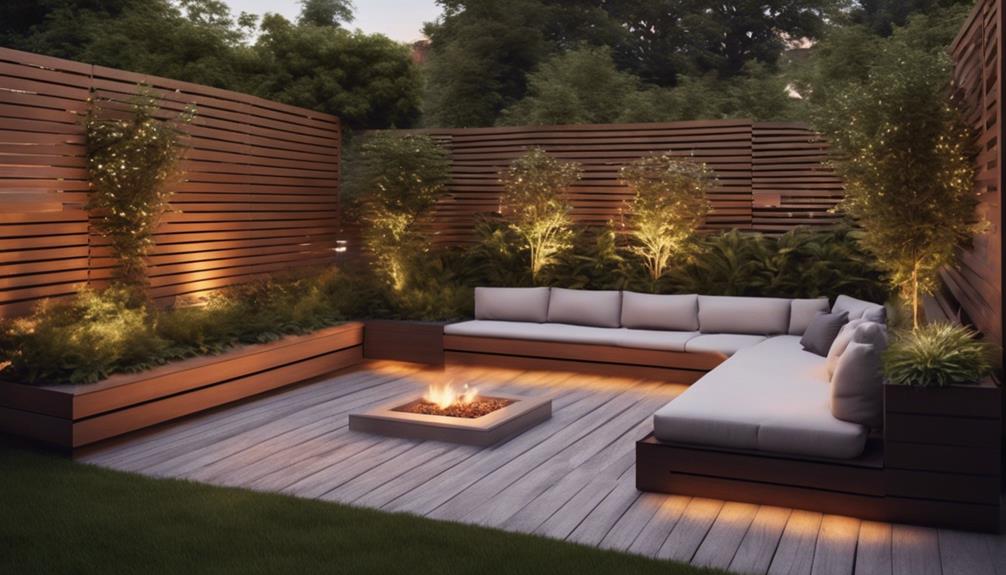
The modern evolution of deck design offers significant advantages that not only transform outdoor living spaces but also contribute to an overall enhancement of property value and aesthetic appeal. These designs often blend functionality and elegance by using premium materials and integrating with existing landscapes to create a cohesive environment.
Homeowners can enjoy an enriched outdoor experience as these well-crafted spaces provide an ideal setting for relaxation and entertainment. In addition, by seamlessly extending the living area of a home into the outdoors, contemporary decks serve as practical additions that blend functionality with visual harmony.
Enhanced Outdoor Experience
Incorporating enhanced outdoor experiences into deck design not only elevates the aesthetic appeal of a home but also substantially boosts its functional value. By thoughtfully integrating elements that cater to relaxation and recreation, homeowners can transform their decks into versatile sanctuaries that seamlessly merge with nature. Enhancements in deck design prioritize comfort, usability, and ambiance, leading to more enriching interactions with the outdoor environment.
Consider these features that paint a vivid picture of an enhanced outdoor experience:
- Multifunctional Seating Arrangements: Incorporating built-in benches or flexible seating options invites relaxation and social gatherings.
- Outdoor Kitchens and Grills: Elevate culinary experiences by easily accommodating dining and entertainment needs in the open air.
- Ambient Lighting: Strategically placed lighting provides warmth and aesthetic allure, extending usability into the evening hours.
- Integrated Sound Systems: Facilitate an immersive sensory experience, enhancing audio enjoyment without compromising spatial harmony.
- Eco-Friendly Materials: Utilizing sustainable resources not only benefits the environment but also enhances durability and visual appeal.
Increased Property Value
Investing in modern deck design trends can greatly enhance a property's marketability and increase its value. As homeowners seek to maximize their returns on property investments, incorporating a well-designed deck can be a strategic move. Decks offer a blend of aesthetic appeal and functional benefits that make a home more attractive to potential buyers.
Current trends focus on sustainable materials, such as composite decking, which not only prolong the life of the structure but also appeal to environmentally conscious buyers, boosting the property's overall desirability.
Moreover, innovative design trends that integrate the natural surroundings, like incorporating natural wood finishes and minimalist railings, contribute to a cohesive architectural style that can tremendously enhance curb appeal. Decks that feature built-in seating, modern lighting solutions, and smart home integrations also highlight a property's uniqueness, offering advanced features that resonate with tech-savvy buyers.
A deck built with modern trends in mind is more than an addition to the exterior of a home; it's a value proposition that speaks to high-quality living and future-forward thinking. By aligning with current tastes and preferences, it positions the property competitively within the real estate market, consequently elevating its financial valuation.
Extended Living Space
Often regarded as a seamless extension of the home's interior, a thoughtfully designed deck enhances the livable area, providing versatile spaces for relaxation, entertainment, and dining. By effectively utilizing the outdoor environment, homeowners can transform underused exterior spaces into an integral component of daily life, contributing considerably to functional living areas.
The ability to extend one's living space outdoors not only increases the overall square footage of usable space but also promotes a lifestyle that harmonizes with nature, as homeowners can take advantage of fresh air and natural surroundings.
When designing a deck, several elements contribute to creating an extended living space:
- Multi-level design: Allows for distinct activity areas such as lounging, cooking, and socializing.
- Outdoor kitchen installations: Include cooking and refrigeration amenities, blurring indoor and outdoor culinary experiences.
- Comfortable seating arrangements: Provide an inviting environment conducive to relaxation and conversation.
- Lighting solutions: Enhance usability during evening hours, ensuring the space remains functional beyond daylight.
- Weather protection features: Such as pergolas and retractable awnings, enable usage in varying weather conditions.
Improved Aesthetic Appeal
As homeowners expand their living spaces outdoors, attention to design detail becomes paramount, leading to enhanced aesthetic appeal. A meticulously designed deck not only augments the overall beauty of a home but also adds substantial value to the property. Selecting materials such as sustainably sourced woods or composite decking introduces both longevity and elegance, marrying form with function.
Complementary color schemes and finishes can elevate the visual allure, harmonizing the deck with the natural landscape and existing architectural elements. Incorporating modern architectural features like minimalist railing systems or integrated lighting solutions further refines the outdoor space. These subtle yet critical enhancements guarantee that the deck serves as a seamless extension of indoor living environments, inviting relaxation and offering a stylish venue for social gatherings.
Innovations in design also encourage the inclusion of multi-level areas or built-in seating, which not only serve practical functions but also contribute intricately to the deck's visual depth and richness.
Composite Material Advantages
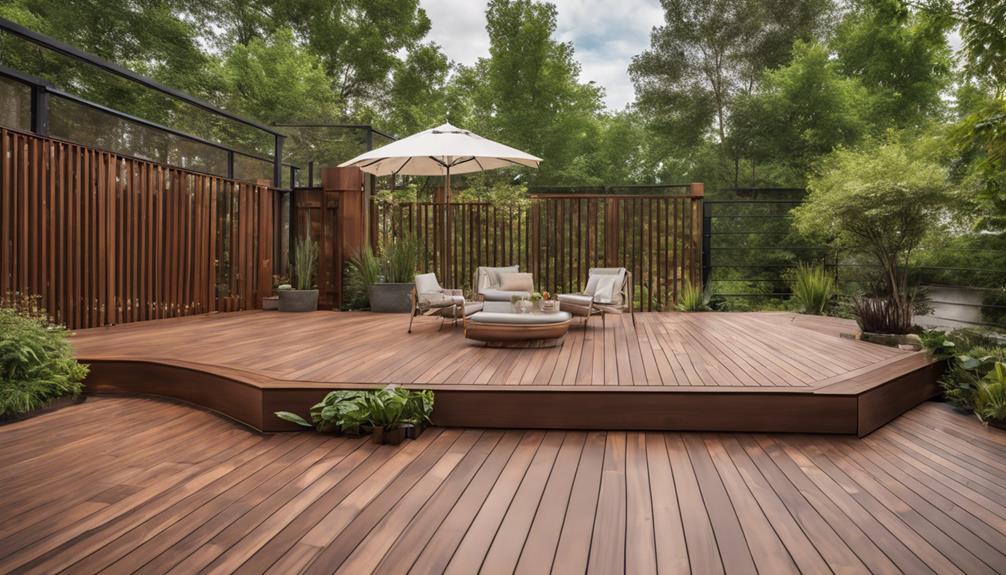
Composite materials have revolutionized deck design by offering unparalleled durability and minimal maintenance requirements, presenting a compelling choice for homeowners seeking both longevity and ease of upkeep. In addition, they provide a sustainable option with eco-friendly material choices that appeal to environmentally conscious individuals aiming to minimize their ecological footprint. The aesthetic versatility of composites allows for a wide range of design possibilities, enabling property owners to personalize their outdoor spaces without compromising on either look or function.
| Benefit | Emotional Impact |
|---|---|
| Durability and Low Maintenance | Peace of mind |
| Eco-Friendly Material Choices | Environmental pride |
| Aesthetic Versatility Options | Creative satisfaction |
Durability and Low Maintenance
Embracing composite materials in deck design stands as an indicator of modern construction's commitment to durability and minimal upkeep. This approach provides homeowners with the luxury of robust deck structures that retain their aesthetic appeal over time while reducing the demands of traditional wooden maintenance regimes. Unlike natural wood, composite materials are engineered to guarantee rotting, warping, and splintering, making them a preferred choice for those seeking longevity.
Incorporating advanced technology, composite decks offer several advantages:
- Fade and Stain Resistance: Designed to withstand the elements and resist stains from spills, composite decking maintains its vivid color and polished appearance.
- Insect and Mold Deterrence: Without the natural fibers that attract pests or foster mold growth, these materials warrant a hygienic, durable surface.
- Cost-Effective Over Time: While initial installation can be higher compared to wood, the long-term savings on maintenance and replacement make it a prudent investment.
- UV Protection: With built-in UV inhibitors, these decks minimize sun damage, preventing fading and material degradation.
- Non-Slip Surface: Enhanced safety is achieved with textured finishes, providing a non-slip surface for family and guests.
Incorporating composite materials warrants that deck designs not only withstand the test of time but also meet modern demands for elegant yet effortless outdoor living spaces.
Eco-Friendly Material Choices
The shift towards sustainable living prompts a reevaluation of the materials used in construction, particularly for outdoor spaces like decks. In this context, composite materials provide an innovative solution, merging ecological responsibility with superior functionality. Comprising a blend of recycled wood fibers and plastic, these materials stand as a testament to the recycling ethos, reducing demand on virgin resources while repurposing what may otherwise contribute to environmental degradation.
Composite materials are heralded not only for their sustainable attributes but also for their durability and low maintenance—an attractive trinity for eco-conscious homeowners. Their resistance to rotting, warping, and insect damage substantially extends the lifespan of decks, compared to traditional wooden counterparts, hence less frequent replacement is necessary, further underpinning their economic and environmental feasibility.
In this context, composite decks do not require the periodic staining or sealing that wood demands, thereby reducing the use of potentially harmful chemicals. Utilizing innovative production processes, manufacturers have succeeded in enhancing the strength and textural appeal of composites, often mimicking the aesthetic warmth of natural wood. This solidifies composite materials as a cornerstone in eco-friendly, practical deck design, marking them as a preferred choice among contemporary builders and homeowners.
Aesthetic Versatility Options
Incorporating aesthetic versatility, composite materials have become a pivot in modern deck design. As homeowners increasingly seek personalized outdoor spaces, composites offer an ideal canvas due to their adaptability and variety. These materials emulate the natural allure of wood without the drawbacks of traditional timber, such as rotting or splintering, and offer an impressive breadth of design opportunities. Composite decking's engineered composition allows for consistent textures and color across expansive areas, creating seamless, sophisticated platforms that cater to stylistic preferences and functional needs alike.
Composite materials provide a range of aesthetic features that can transform any outdoor space into a visually enthralling and enduring structure. Consider the following versatile options available with composite decking:
- Variety of finishes: From rustic textures resembling aged wood to sleek, contemporary lines.
- Color spectrum: Natural earth tones, deep hues, and custom color matches.
- Design flexibility: Capability to encircle unique architectural elements or create multi-level decks.
- Integrated lighting options: Enhance ambiance with step lights or rail illuminations.
- Textural diversity: Choose from smooth, brushed, or embossed surfaces.
The impact of composite decking stretches beyond aesthetics, as it boasts durability and minimal maintenance requirements, ensuring that any chosen style remains vibrant over time without the labor-intensive upkeep associated with wood.
Decks FAQ
What Are Some Color Trends for Deck Design in 2024?
In 2024, deck design color trends are gravitating towards earthy tones such as terracotta and olive green, alongside muted grays and blues. These choices reflect a growing preference for natural aesthetics that seamlessly integrate with surrounding environments.
How Do I Integrate Eco-Friendly Components Into My Deck Design?
To integrate eco-friendly components into deck design, select sustainable materials like composite or reclaimed wood, implement solar lighting, and incorporate native plantings. Guarantee eco-conscious practices by using non-toxic stains and opting for permeable decking solutions to reduce runoff.
Are There Budget-Friendly Options for Achieving a Stylish Deck Look?
Absolutely, opting for cost-effective materials like pressure-treated wood or recycled composite boards can offer style without high expenses. Integrating modular furniture and versatile lighting also enhances aesthetic appeal at a reasonable cost, ensuring budget adherence.
What Deck Lighting Options Are Currently Popular?
Current deck lighting trends emphasize energy efficiency and aesthetic appeal, with LED fixtures, solar-powered lights, and smart home integration being particularly favored. Additionally, recessed and low-voltage lighting designs are popular for their ability to create ambient atmospheres.
How Can I Incorporate Water Features Into My Deck Design?
Incorporating water features into your deck design can enhance ambiance and tranquility. Consider adding a small fountain, pond, or waterfall. Guarantee proper drainage and waterproofing measures are in place to protect the deck's structural integrity.

